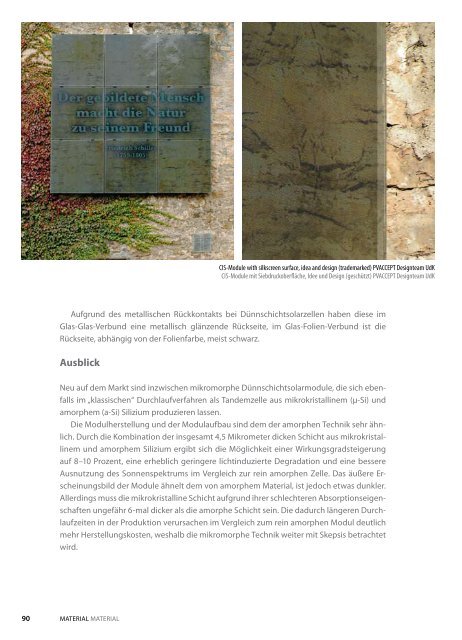Energizing Architecture
978-3-939633-71-6
978-3-939633-71-6
Sie wollen auch ein ePaper? Erhöhen Sie die Reichweite Ihrer Titel.
YUMPU macht aus Druck-PDFs automatisch weboptimierte ePaper, die Google liebt.
CIS-Module with silkscreen surface, idea and design (trademarked) PVACCEPT Designteam UdK<br />
CIS-Module mit Siebdruckoberfläche, Idee und Design (geschützt) PVACCEPT Designteam UdK<br />
Schott office building Sant Adrià de Besòs (ES): thin-film modules,<br />
back side with colored glass Schott Verwaltung, Sant Adrià de<br />
Besòs (E): Dünnschichtmodule, rückseitig mit farbigen Gläsern<br />
“ARTLine Invisible” CIS-Modules with color glass cover<br />
„ARTLine Invisible“ CIS-Module mit farbigen Deckgläsern<br />
Aufgrund des metallischen Rückkontakts bei Dünnschichtsolarzellen haben diese im<br />
Glas-Glas-Verbund eine metallisch glänzende Rückseite, im Glas-Folien-Verbund ist die<br />
Rückseite, abhängig von der Folienfarbe, meist schwarz.<br />
Ausblick<br />
Neu auf dem Markt sind inzwischen mikromorphe Dünnschichtsolarmodule, die sich ebenfalls<br />
im „klassischen“ Durchlaufverfahren als Tandemzelle aus mikrokristallinem (µ-Si) und<br />
amorphem (a-Si) Silizium produzieren lassen.<br />
Die Modulherstellung und der Modulaufbau sind dem der amorphen Technik sehr ähnlich.<br />
Durch die Kombination der insgesamt 4,5 Mikrometer dicken Schicht aus mikrokristallinem<br />
und amorphem Silizium ergibt sich die Möglichkeit einer Wirkungsgradsteigerung<br />
auf 8–10 Prozent, eine erheblich geringere lichtinduzierte Degradation und eine bessere<br />
Ausnutzung des Sonnenspektrums im Vergleich zur rein amorphen Zelle. Das äußere Erscheinungsbild<br />
der Module ähnelt dem von amorphem Material, ist jedoch etwas dunkler.<br />
Allerdings muss die mikrokristalline Schicht aufgrund ihrer schlechteren Absorptionseigenschaften<br />
ungefähr 6-mal dicker als die amorphe Schicht sein. Die dadurch längeren Durchlaufzeiten<br />
in der Produktion verursachen im Vergleich zum rein amorphen Modul deutlich<br />
mehr Herstellungskosten, weshalb die mikromorphe Technik weiter mit Skepsis betrachtet<br />
wird.<br />
Surfaces vary depending on materiality. CIS modules take on a dark-gray or dark-blue to<br />
black appearance, CdTe modules are dark green to black in appearance, and a-SI modules<br />
are reddish to brown-black.<br />
Apart from material color, there are many ways to color thin-film modules. One option is<br />
to print color on the front glass surface using silkscreen printing. This technology is currently<br />
only available for CIS modules; it is being developed under the auspices of a EU research<br />
project called PVACCEPT. Because the CIS-area underneath the printed area is not photoactive,<br />
the pattern should consist of many one-millimeter dots, evenly distributed across the<br />
module’s surface area. This prevents “hot spots” from developing, which would result from<br />
completely covering a cell, also leading to reduced module output and cell damage. Depending<br />
upon the desired clarity of a motif, a print level of between 10 and 20 percent is<br />
sufficient.<br />
In combination with insulation glass, colored modules can be built for integration into<br />
buildings by coloring the rear glass sheet of the insulation glass compound. Another way of<br />
coloring thin-film solar modules is to combine a raw module with a colored front glass sheet.<br />
However, such solar modules still appear black, despite colored glass cover. For this reason,<br />
a process is underway under the auspices of the EU at the Zentrum für Sonnenenergie- und<br />
Wasserstoff-Forschung Baden-Württemberg (ZSW), to develop a method of preserving the<br />
chromaticity of the glass cover by inserting a layer of air between the colored front glass<br />
pane and the CIS raw module. Modules of this type can incur output losses of about 10<br />
to 30 percent in comparison with opaque black modules. Power fluctuations are strongly<br />
dependent on the chosen front glass color. Modules of this type are not yet available on<br />
the market, although the Würth Company already produces colored CIS modules. They are<br />
marketed under the name “ARTLine Invisible” and, in addition to the “original” black, also<br />
90 Material Material Thin-Film Modules Dünnschichtmodule 91


















